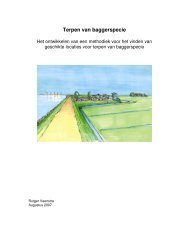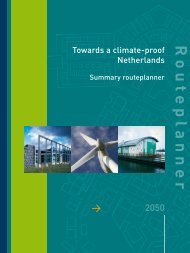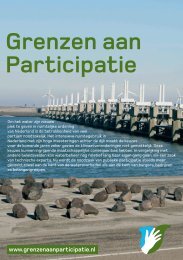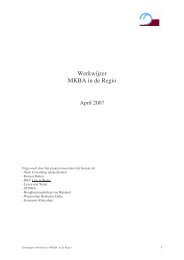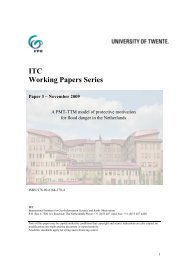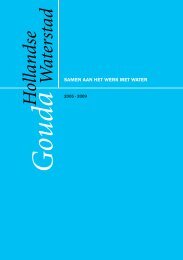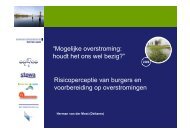Deltas on the move; Making deltas cope with the effects of climate c
Deltas on the move; Making deltas cope with the effects of climate c
Deltas on the move; Making deltas cope with the effects of climate c
- No tags were found...
Create successful ePaper yourself
Turn your PDF publications into a flip-book with our unique Google optimized e-Paper software.
KvR report 001/2006Wave-dominated <strong>deltas</strong>In o<strong>the</strong>r <strong>deltas</strong>, wave currents play an important role. These <strong>deltas</strong> c<strong>on</strong>sist primarily<strong>of</strong> broad, sandy lobes and have a smooth arched form (see photo). In wavedominated<strong>deltas</strong>, <strong>the</strong> sediment supplied by <strong>the</strong> rivers is reworked by waves andcurrents and is <strong>the</strong>n redeposited al<strong>on</strong>g <strong>the</strong> coast in <strong>the</strong> form <strong>of</strong> beach ridges, barriersand spits. Wave-dominated <strong>deltas</strong> <strong>the</strong>refore do not protrude far into <strong>the</strong> sea but havea wide, flat form.The Sao Francisco River in Brazil rises in<strong>the</strong> coastal mountains <strong>of</strong> Brazil and flowsinto <strong>the</strong> Atlantic Ocean via <strong>on</strong>e singledistributary. Str<strong>on</strong>g l<strong>on</strong>g shore currentscarry <strong>the</strong> sediment al<strong>on</strong>g <strong>the</strong> coast. Thehigh wave energy produces a relativelysmooth delta shoreline <strong>with</strong> <strong>on</strong>ly a minorprotrusi<strong>on</strong> at <strong>the</strong> river mouth. The deltaplain is composed almost entirely <strong>of</strong>closely spaced beach ridges <strong>with</strong> narrowswales and eolian dunes. The <strong>deltas</strong>horeline is composed <strong>of</strong> large, broadsandy beaches (Hart & Coleman, 2004).Tide-dominated <strong>deltas</strong>Tide-dominated <strong>deltas</strong> like <strong>the</strong> Mahakam (see photo) are characterized by rivermouths that quickly expand and deepen in <strong>the</strong> directi<strong>on</strong> <strong>of</strong> <strong>the</strong> sea. This is ac<strong>on</strong>sequence <strong>of</strong> <strong>the</strong> large quantity <strong>of</strong> water flowing from <strong>the</strong> sea into <strong>the</strong> river twice aday. A river mouth thus takes <strong>on</strong> <strong>the</strong> form <strong>of</strong> an estuary, <strong>with</strong> sand banks, mudflatsand salt marshes al<strong>on</strong>g <strong>the</strong> banks. This is particularly <strong>the</strong> case if inland lakes andlago<strong>on</strong>s are c<strong>on</strong>nected <strong>with</strong> <strong>the</strong> river and also fill up <strong>with</strong> tidal water. During stormtides, <strong>the</strong> sea water can reach far into <strong>the</strong> delta via <strong>the</strong> wide river mouth, inundatinglarge areas. In this way, sediment that had already been deposited in <strong>the</strong> sea can beredeposited by <strong>the</strong> sea <strong>on</strong> <strong>the</strong> delta plain.The Mahakam river rises at <strong>the</strong> borders <strong>of</strong>Ind<strong>on</strong>esia and Malaysia <strong>on</strong> <strong>the</strong> island <strong>of</strong>Kalimantan. The delta plain has a classicfan-shaped form <strong>with</strong> many distributaries.Numerous sinuous tidal channels scar <strong>the</strong>delta surface. Behind <strong>the</strong> delta fr<strong>on</strong>t, tidalmudflats dominate. Most <strong>of</strong> <strong>the</strong> delta plain isactively accreting. Wave energy is extremelylow and few beaches are present al<strong>on</strong>g <strong>the</strong>shoreline (Hart & Coleman, 2004).<str<strong>on</strong>g>Deltas</str<strong>on</strong>g> <strong>on</strong> <strong>the</strong> <strong>move</strong>2.4 <str<strong>on</strong>g>Deltas</str<strong>on</strong>g> and natureThe large variety <strong>of</strong> water types, substrate and dynamic processes make <strong>deltas</strong> richin natural biotopes. With <strong>the</strong> water, <strong>the</strong> river brings large quantities <strong>of</strong> nutrients to <strong>the</strong>delta where <strong>the</strong>se are transformed into food for many organisms. Sedimentati<strong>on</strong> <strong>of</strong>organic material and <strong>the</strong> subsequent decompositi<strong>on</strong> purifies <strong>the</strong> adjacent coastalwaters from <strong>the</strong>ir organic load and is <strong>on</strong>e major source for <strong>the</strong> high biologicalproducti<strong>on</strong>. This is called <strong>the</strong> “biological pump”.Biological productivity in coastal waters near <strong>deltas</strong> is am<strong>on</strong>g <strong>the</strong> highest reportedanywhere in <strong>the</strong> sea (e.g. Kaiser et al., 2005). <str<strong>on</strong>g>Deltas</str<strong>on</strong>g> are <strong>the</strong>refore an importantnursery for fish, and a stepping-st<strong>on</strong>e for birds <strong>on</strong> migrati<strong>on</strong> that are dependent <strong>on</strong><strong>the</strong> food <strong>the</strong>y find in its lago<strong>on</strong>s, tidal flats and mangroves.Most plants and animals in <strong>deltas</strong> are adapted to <strong>the</strong> extreme envir<strong>on</strong>mentalc<strong>on</strong>diti<strong>on</strong>s and <strong>of</strong>ten occur in high abundance. Many species in <strong>deltas</strong> are endemic.One strategy to inhabit such a permanently changing envir<strong>on</strong>ment is a highreproducti<strong>on</strong> capacity.Many <strong>deltas</strong> are rich in riverine forests, tidal flats and mangroves. Birds <strong>of</strong>tenestablish large breeding col<strong>on</strong>ies in <strong>the</strong> trees, e.g. pelicans and her<strong>on</strong>s. The nutrientsfrom <strong>the</strong> river also 'feeds' <strong>the</strong> sea in fr<strong>on</strong>t <strong>of</strong> <strong>the</strong> delta and <strong>the</strong> shallow waters <strong>of</strong> <strong>the</strong>delta fr<strong>on</strong>t are am<strong>on</strong>gst <strong>the</strong> richest marine ecosystems.2.5 <str<strong>on</strong>g>Deltas</str<strong>on</strong>g> and <strong>climate</strong> changeDue to <strong>the</strong>ir positi<strong>on</strong> <strong>on</strong> <strong>the</strong> border between land and sea, <strong>deltas</strong> are very sensitive to<strong>climate</strong> changes. Climate research has dem<strong>on</strong>strated that <strong>the</strong> global temperature isset to increase by a few degrees, resulting in <strong>the</strong> wea<strong>the</strong>r becoming much moreextreme in many places, <strong>with</strong> more storms and changed river discharges. Due to<strong>climate</strong> change extreme circumstances <strong>with</strong> floods, heat-waves, mudflows etc willincrease <strong>with</strong> as a result losses <strong>of</strong> natural habitats like wetlands, damage toinfrastructure and buildings especially near <strong>the</strong> coast and al<strong>on</strong>g rivers (IPCC, 2001b).The sea level will also rise faster than in <strong>the</strong> preceding centuries (IPCC, 2001a).These changes will have a severe impact <strong>on</strong> <strong>the</strong> natural processes in <strong>deltas</strong> and in<strong>the</strong> lives <strong>of</strong> those living in <strong>the</strong>se areas. The ec<strong>on</strong>omic losses can be enormous. Forexample <strong>on</strong>e severe storm in December 1999 caused a loss <strong>of</strong> 6 billi<strong>on</strong> Euro inWestern Europe.The following aspects <strong>of</strong> <strong>climate</strong> change could have an effect <strong>on</strong> <strong>the</strong> processes atwork <strong>with</strong>in a delta:TemperatureThe main effect <strong>of</strong> a higher temperature is <strong>the</strong> rising <strong>of</strong> <strong>the</strong> sea level, due to both <strong>the</strong>melting <strong>of</strong> ice and <strong>the</strong> expansi<strong>on</strong> <strong>of</strong> <strong>the</strong> sea water as it warms. Coastal processes will<strong>the</strong>n become str<strong>on</strong>ger, resulting in more erosi<strong>on</strong>. Relatively speaking, less sedimentwill be available for <strong>the</strong> build-up <strong>of</strong> <strong>the</strong> delta fr<strong>on</strong>t, so <strong>the</strong> delta fr<strong>on</strong>t will shift inland.With a rapidly rising sea level, <strong>the</strong> shortage <strong>of</strong> sediment could become so severe that<strong>the</strong> delta “drowns” and disappears under <strong>the</strong> water permanently.1617



